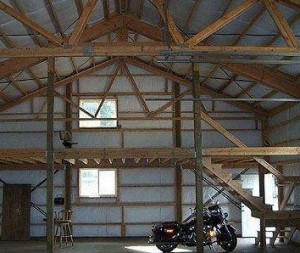I’ve come to face a reality – the great majority of people are dimensionally challenged. And it is OK if you might be one of them. I’ve worked with dimensions and sizes of all sorts and shapes since I was a teenager swinging a hammer (and being go-fer) on the buildings my Father and Uncles were framing.
A case in point just this morning – a client had requested a quote on a building (happens a few hundred times every day for us, so nothing surprising there).
The building was requested with a 10 foot eave height, as well as a 10 foot tall overhead door. Obviously a challenge as the tracks for the door need somewhere to go – solution easily taken care of, make the eave height 12 feet. Crisis averted.
Now, the fun part….
This same client requested a full loft 30’x40’ in a 30’x40’ building, with a 4/12 roof slope.
The 4/12 roof slope means the height of the roof increases by four feet, for every 12 feet of horizontal travel. In this particular building, being 30 foot wide, it would be five feet taller in the center.
Now I am vertically challenged – I am tall enough so if I am wearing my favorite cowboy boots, my head brushes the tops of doors as I walk through them. But, having been this height for my entire adult life, I have gotten used to it.
With only five feet of rise in the center, this requested full loft would cause vertical challenges for nearly everyone!
When it comes to actually planning usable loft space, give some thought to the space being created.
 For a full loft (sidewall-to-sidewall), at the very least there should be four feet of height above the loft floor at the outside eave wall. As floor and roof systems have a thickness – use this for a guideline:
For a full loft (sidewall-to-sidewall), at the very least there should be four feet of height above the loft floor at the outside eave wall. As floor and roof systems have a thickness – use this for a guideline:
Take the height of the tallest large door (sliding or overhead). Add a foot above a sliding door and at least two feet above an overhead door (an extra foot is even better). This will be the top of floor height. Now to this number, add the minimum amount of height at the lowest point of the loft plus allow for the roof system (this number should always be at least five).
This resultant will be the minimum eave height.
Example: Your tallest door (which happens to be an overhead) is 8’ – plus 2’ for the overhead – 8 + 2 + 10’ is the top of floor height. Adding in at least 5’ you end up with 15’ and since lumber is most economical in 2’ lengths – and look back where I said “another foot is even better) – final eave height is 16’.






